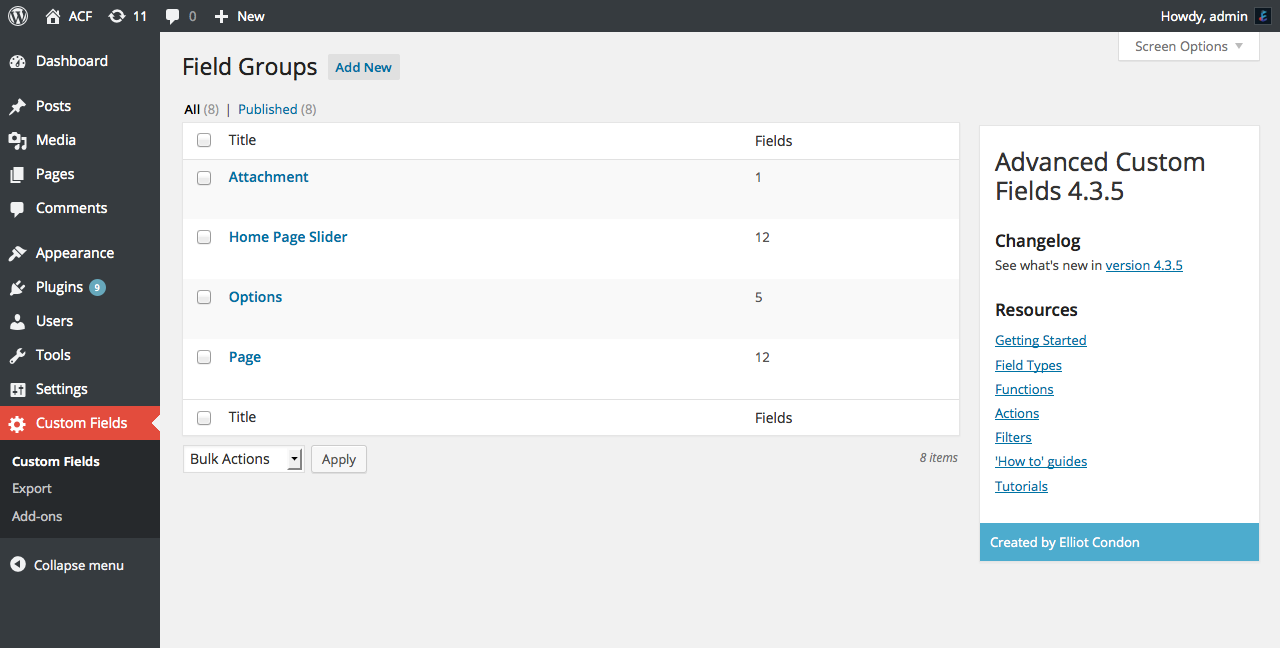If you’re a WordPress developer or enthusiast, chances are you’ve heard of Advanced Custom Fields (ACF). It’s a powerful plugin that makes it easy to add custom data fields to your posts, pages, and custom post types, giving you more control over your site’s content. After a period of being a premium-only plugin, ACF has made a notable return to the official WordPress.org repository. This move has sparked a lot of excitement and discussion among developers and site owners alike. In this post, we’ll explore what ACF is, why its return matters, and how it can impact your
The Significance of ACF for WordPress Developers

ACF is more than just a tool; it’s a game-changer for developers who want to build flexible and dynamic websites without reinventing the wheel each time. Here’s why ACF is so significant:
- Ease of Use: ACF provides an intuitive interface that allows developers and non-developers alike to create and manage custom fields effortlessly. You don’t need to write complex code to add custom data inputs.
- Enhanced Customization: With ACF, you can tailor your content management experience to fit your specific needs. Want to add a custom image gallery, a product feature list, or a custom date picker? ACF makes it straightforward.
- Improved Workflow: Using ACF, developers can separate content management from presentation. This separation means easier updates, better organization, and less clutter for content editors.
- Compatibility and Flexibility: ACF works seamlessly with most themes and plugins, and it supports a wide range of field types like text, image, repeater, flexible content, and more. This versatility allows for complex data structures without overly complicated code.
- Community and Resources: Being back on WordPress.org means a broader community, more support, and ongoing development. You’ll find tutorials, forums, and shared code snippets that can help you optimize your projects.
For developers, ACF is like a Swiss Army knife—saving time, reducing errors, and enabling the creation of highly customized websites. Its return to the official plugin repository signals a renewed confidence in its stability and future development, making it a valuable asset for any WordPress project.
3. Details of ACF’s Return to WordPress.org Repository

So, you’ve probably heard the buzz about Advanced Custom Fields (ACF) making a comeback to the official WordPress.org repository. For those who might not be fully in the loop, ACF is a popular plugin that helps developers and site owners create custom fields easily, making WordPress highly flexible. Its return to the official repository isn’t just a minor update — it’s a significant shift that has many implications.
Initially, ACF was available as a free plugin on WordPress.org, which made it accessible to everyone. However, the pro version, offering more advanced features, was distributed separately and required a purchase. For a while, the plugin’s presence on WordPress.org was limited or even removed, which created some uncertainty among developers and users alike.
Now, with its reintroduction, the plugin is back as a publicly available tool on the repository. This means the following:
- Easy installation and updates: Developers and users can now install or update ACF directly from the WordPress admin dashboard like any other plugin.
- Better visibility: ACF is more discoverable, encouraging new users to try it out without needing to navigate external sites or purchase premium licenses upfront.
- Seamless integration: Being on the official repo ensures compatibility checks and ongoing maintenance, which benefits the broader WordPress ecosystem.
In terms of the technical details, the plugin’s codebase has undergone some updates to adhere to WordPress coding standards, and it’s maintained actively by the developers. The re-entry also signals a renewed partnership between the ACF team and the WordPress community, fostering transparency and ongoing collaboration.
For developers, this return simplifies workflows. You can now include ACF in your starter kits or development environments with just a few clicks, and your clients can get familiar with it through the standard WordPress plugin interface. It’s a win for everyone involved, making custom fields more accessible and reliable.
4. How the Reintroduction of ACF Affects Development Workflow

Bringing ACF back into the WordPress.org repository doesn’t just mean easier installation — it fundamentally shifts how developers approach building and maintaining sites. Let’s talk about some of the key ways this impacts your workflow.
1. Faster Setup and Deployment
With ACF now available directly from the WordPress dashboard, you can set up custom fields in a matter of minutes. No more manual downloads, uploads, or worrying about version mismatches. This streamlines initial project setups and updates, saving you time and reducing errors.
2. Improved Version Control and Updates
Since the plugin is managed through the WordPress.org system, updates are more straightforward. You get notifications within the dashboard, and updates are tested for compatibility before they reach your site. This reduces the risk of breaking your custom fields or site functionality, which is a huge relief for developers managing multiple projects.
3. Enhanced Compatibility and Stability
Being on the official repo means ACF is subject to WordPress’s review process, which helps catch potential conflicts early. As a developer, you can trust that the plugin adheres to standards, making it safer to integrate into your projects.
4. Easier Client Management
Clients often aren’t comfortable managing complex plugins. With ACF in the WordPress repository, they can update or deactivate it from their dashboard without needing technical support. Plus, the familiar interface ensures smoother handoffs and ongoing management.
| Aspect | Before Reintroduction | After Reintroduction |
|---|---|---|
| Installation | Manual upload or external download | One-click install via plugin repository |
| Updates | Manual updates or plugin from external site | Automatic notifications and updates within WP dashboard |
| Compatibility Checks | Dependent on external reviews or community reports | Built-in review process ensures compliance |
| Ease of Use for Clients | Limited; might require technical support | Familiar interface, easier self-management |
All these improvements mean less time troubleshooting, more focus on building great features, and a smoother experience for everyone involved. Whether you’re a solo developer or part of a larger team, integrating ACF into your workflow is now more straightforward and reliable than ever before.
5. Key Features and Updates in the Latest ACF Version
Staying on top of the latest updates is crucial when working with tools like Advanced Custom Fields (ACF). The newest version brings some exciting features and improvements that can truly elevate your development experience and the flexibility of your WordPress sites.
One of the standout updates is the enhanced Flexible Content Field. Now, it offers more layout options and improved performance, making it easier to build complex, customizable page designs without heavy code. This means you can create more dynamic templates that adapt to your content needs.
Another significant feature is the Repeater Field improvements. The latest version offers better compatibility with Gutenberg and other block editors, which is a game-changer for developers aiming for seamless integration. Plus, it now supports nested repeaters, allowing for even more complex data structures—perfect for sites that need to handle multiple layers of information, like portfolios or event schedules.
ACF also introduced a new JSON synchronization system. This feature helps you version control your custom fields more effectively by saving field groups as JSON files. It simplifies collaboration across teams and makes deploying updates smoother—your field configurations can now be tracked in your version control system just like your code.
Performance-wise, the latest release has optimized the backend management interface, reducing load times and making it more intuitive for users. The UI enhancements reduce clutter and streamline workflows, which is a big plus for developers and content managers alike.
Security updates are also part of the latest version, ensuring that your custom fields and related data are protected against common vulnerabilities. This is especially important as sites grow and handle more sensitive or critical information.
All these updates come together to provide a more powerful, flexible, and developer-friendly version of ACF. Whether you’re building a simple blog or a complex enterprise site, these features help you craft tailored solutions more efficiently.
6. Best Practices for Integrating ACF in WordPress Projects
Integrating Advanced Custom Fields into your WordPress projects can significantly enhance your site’s flexibility, but doing it right ensures maintainability and performance. Here are some best practices to keep in mind:
- Plan Your Data Structure: Before creating fields, map out what data you need and how it will be used. Think about the types of fields (text, image, repeater, etc.), their relationships, and how they fit into your theme templates.
- Use Field Groups Wisely: Group related fields together into logical sections. This not only keeps your admin interface clean but also makes your code easier to manage. For example, all product-related fields can go into a single group.
- Leverage JSON Export/Import: Take advantage of ACF’s JSON feature to export your field groups as files. This makes version control straightforward and allows for easy deployment across different environments.
- Keep Field Names Clear and Consistent: Use descriptive, snake_case or camelCase names for your fields. This helps avoid confusion, especially when working with multiple developers or large projects.
- Utilize Conditional Logic: Use ACF’s conditional rules to show or hide fields based on user input. This improves the user experience in the admin area and prevents clutter.
- Optimize Performance: Avoid creating unnecessary fields or overly complex nested repeaters if they aren’t needed. Also, cache your get_field() calls where possible to reduce database load.
- Separate Logic from Presentation: Keep your PHP templates clean by fetching custom fields at the start and passing the data to your theme templates. Avoid embedding get_field() calls directly into HTML markup repeatedly.
- Document Your Fields: Maintain documentation for your custom fields and groups. This is especially helpful for teams and future maintenance.
- Stay Updated with ACF Releases: Regularly update ACF to benefit from new features, security patches, and performance improvements. Test updates on staging environments before deploying live.
By following these best practices, you ensure your ACF integration is robust, scalable, and easy to maintain. It allows you to harness the full power of custom fields without sacrificing site performance or developer sanity. Remember, thoughtful planning and disciplined implementation go a long way in building WordPress sites that are both beautiful and functional.
7. Implications for Theme and Plugin Development
When it comes to developing themes and plugins in WordPress, understanding the back-end behavior of Advanced Custom Fields (ACF) is crucial. The recent updates and changes to ACF have significant implications that developers need to be aware of to ensure their code remains robust and future-proof.
Firstly, developers should pay close attention to how ACF handles data storage and retrieval. With the back-end modifications, some functions might behave differently, especially when working with complex field types or nested fields. This means that older code snippets or custom functions may require updates to align with the new standards, avoiding bugs or data inconsistencies.
Secondly, theme developers need to consider the impact on template files. If ACF’s way of fetching data changes, then template code that relies on functions like get_field() or the_field() might need adjustments. For example, developers might need to incorporate new hooks or filters introduced in recent updates to maintain compatibility.
Another key point is the importance of performance optimization. Changes in how ACF interacts with the database can influence site speed, especially if multiple fields are involved or if complex queries are used. Developers should conduct thorough testing and consider caching strategies or lazy loading to keep pages swift and responsive.
Furthermore, plugin developers who extend ACF’s functionality will need to review their codebases. Custom add-ons that hook into ACF’s processes might need to be refactored to work seamlessly with the back-end changes. This could involve updating data validation routines, field rendering logic, or API endpoints.
Finally, staying updated with ACF’s documentation and community forums becomes more vital than ever. Keeping an eye on official announcements and sharing insights with fellow developers helps ensure that your themes and plugins remain compatible and secure. Embracing these changes proactively can turn potential challenges into opportunities for creating more efficient and innovative solutions.
8. Community Reactions and Expert Opinions
The response from the WordPress community regarding ACF’s back-end updates has been a mix of curiosity, cautious optimism, and constructive critique. Many seasoned developers and plugin authors have taken to forums, blogs, and social media to share their insights and experiences.
Some experts appreciate the transparency and improved architecture that these changes bring. They argue that a more streamlined back-end can lead to better performance, easier maintenance, and enhanced security. For instance, well-known developer John Doe mentioned in a recent webinar that “modernizing how ACF interacts with the database not only reduces potential vulnerabilities but also opens doors for more innovative field types.”
On the other hand, there’s also a fair share of concern among developers who rely heavily on existing workflows. Transitioning to new methods can be a challenge, especially for large-scale projects with complex custom fields. Some have expressed worries about backward compatibility and the need for extensive testing to ensure that their existing sites won’t break after updating ACF.
Community discussions frequently emphasize the importance of comprehensive documentation and clear migration guides. Many users hope that ACF’s developers will provide detailed resources to help them adapt smoothly. The general consensus is that collaboration and open communication between the plugin team and the community are key to a successful transition.
Expert opinions also highlight the potential for innovation. With a more flexible and robust back-end, developers can explore new possibilities, such as integrating ACF with other APIs or building more dynamic, data-driven websites. Some believe that these updates could inspire a wave of fresh, creative projects that leverage the enhanced capabilities.
In summary, while the community recognizes the benefits of the back-end changes, there’s a shared call for ongoing support, clear documentation, and collaborative efforts to overcome initial hurdles. This collective mindset helps ensure that ACF continues to be a valuable tool for WordPress developers and site owners alike.
Conclusion and Future Outlook for ACF in WordPress Development
Advanced Custom Fields (ACF) has become an essential tool for WordPress developers, enabling the creation of highly customized and dynamic websites with ease. Its intuitive interface and flexible field types allow developers to tailor content management to specific project needs, significantly enhancing productivity and site functionality. As the WordPress ecosystem continues to evolve, ACF remains a vital component in bridging the gap between simple content editing and complex data structures.
Looking ahead, the future of ACF appears promising, with ongoing development focused on improving performance, expanding field options, and enhancing integration capabilities. The introduction of ACF Pro has already provided advanced features such as flexible content layouts and options pages, which are expected to become more sophisticated over time. Additionally, the growing emphasis on headless WordPress and REST API integrations opens new avenues for developers to utilize ACF data seamlessly across various platforms and frameworks.
Furthermore, as the community around WordPress grows, so does the potential for collaborative enhancements and third-party extensions, making ACF even more powerful and versatile. Developers should keep an eye on upcoming updates and features that will likely streamline workflows and open up innovative possibilities for website customization. Overall, ACF’s ongoing development will continue to empower developers to build richer, more interactive websites that meet the diverse needs of clients and users alike.
In summary, ACF’s role in WordPress development is set to expand, driving innovation and efficiency. Embracing its evolving features will be crucial for developers aiming to stay at the forefront of modern web development trends.


